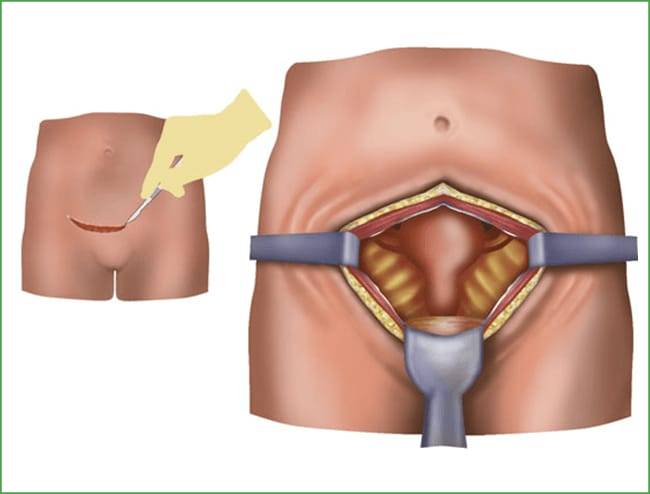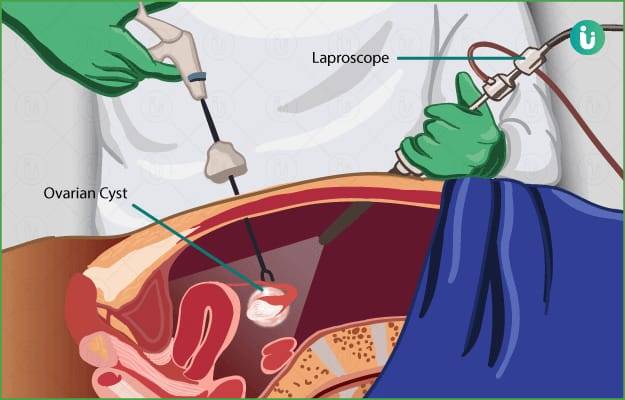Ovarian Cystectomy
What is Ovarian Cystectomy?
An ovarian cystectomy is surgery to remove a cyst from your ovary.
What are the different types of surgery for ovarian cystectomy?
An open surgery requires an abdominal incision large enough that the doctor can see the cyst and surrounding tissue. It may be done instead of a laparoscopic surgery if the cyst is large, there are many cysts, or complications develop during a laparoscopic surgery.

When is surgery for ovarian cyst removal advised?
- Ovarian growths (masses) are present in both ovaries.
- An ovarian cyst that is being watched does not get smaller or go away in 2 to 3 months.
- An ultrasound exam suggests that a cyst is not a simple functional cyst.
- You have an ovarian growth and you:
Have never had a menstrual period (for example, a young girl). - Have been through menopause (postmenopausal woman).
- Use birth control pills (unless you are using low-dose progestin-only pills or have missed a pill, which would make an ovulation-related functional cyst more likely).
- Your doctor is concerned that ovarian cancer may be present. In this case, it is also advised that you see a gynecologic oncologist.
Treatments & Procedures
What are Risks factors of ovarian surgery ?
- Ovarian cysts may come back after a cystectomy.
- Pain may not be controlled.
- Scar tissue (adhesions) may form at the surgical site, on the ovaries or fallopian tubes, or in the pelvis.
- Infection may develop.
What to Expect Prior to Procedure ?
Your doctor may do the following:
- Physical exam
- Review of medications
- Blood tests
- Urine test
- CT scan —a type of x-ray that uses a computer to make pictures of organs
- Ultrasound —a test that uses sound waves to examine the abdomen
Anesthesia
General anesthesia will be used. It will block pain and keep you asleep through the surgery. It will be given through an IV in your hand or arm.

Laparoscopic Procedure
Description of the Laparoscopic Procedure:
A small incision will be made just below the navel. Next, a laparoscope will be inserted. This is a thin tube with a camera on the end. To allow the doctor to better view the organs, carbon dioxide gas will be pumped into the abdomen. The laparoscope will be used to locate the cyst. When it is found, 1 or 2 more incisions will be made. Surgical instruments will be inserted to remove the cyst. Tissue may be removed for testing. If cancer is found, both ovaries may need to be removed. After the cyst is removed, the instruments will be removed. The incision area will be closed with stitches or staples.
In some cases, the doctor may switch to an open surgery . During an open surgery, a larger incision will be made in the abdomen to do the surgery.

Immediately After Procedure :
After the procedure, you will be given IV fluids and medications while recovering.
How Long Will It Take?
1-2 hours
Will it hurt?
There will be slight pain after the surgery. You will be given pain medication.
Average Hospital Stay:
You may stay overnight, or you may be able to leave the hospital the same day as your surgery.
Post-procedure Care :
During your stay, the hospital staff will take steps to reduce your chance of infection such as:
- Washing their hands
- Wearing gloves or masks
- Keeping your incisions covered
OPD Timings
Dr. Mandar R Gadgil
| Mon – Fri | - | 4:30 PM - 7:30 PM w.e.f. 27th August 2022 |
| Saturday | - | 10:00 AM - 11:30 AM |
OPD Timings
Dr. Maithilee Gadgil
| MON – SAT | - | 10:00 AM - 12:30 PM |
| MON – FRI | - | 4:30 PM - 07:00 PM w.e.f. 27th August 2022 |
Any Question Or Query
Feel free to ask for your any Question or Query /
Book An Appointment
Appointment
To book appointment call us on

